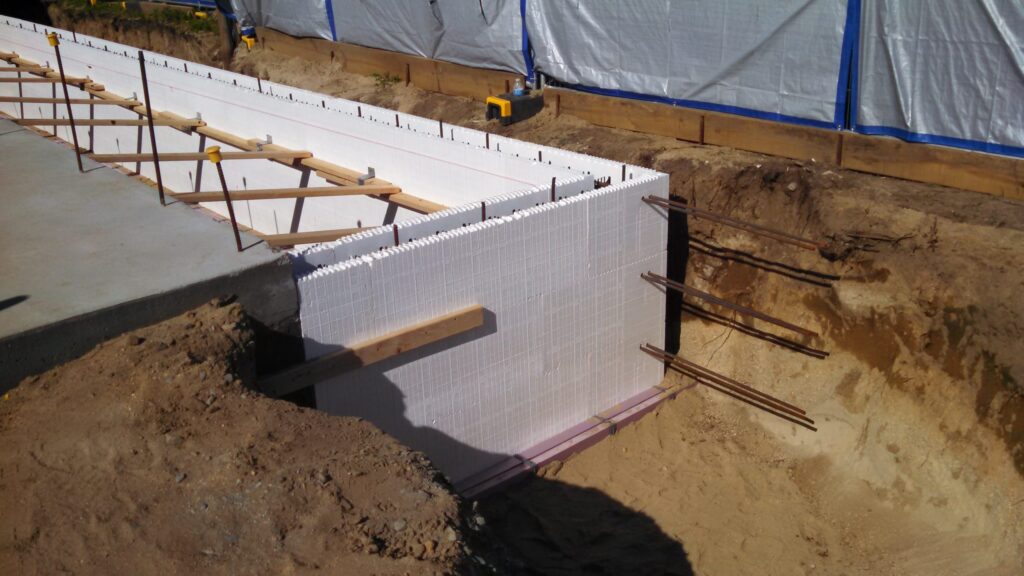Secrets To Building Good Concrete Footings

Building good concrete footings is no secret and requires some basic rules that are easy to follow but are also easy to ignore. No matter what the structure is that is going to sit on your footings be it a house, a shed, or a deck if the footing is weak or sits on unstable soils the footing is useless. Almost all good construction drawings will have some details as to the size of the footings required, the strength of the concrete the architect requires, and so on. Using 2000-pound concrete where 4000 pounds is required, is a sure bet the footing will fail. Cheating on the footing size or making it ten inches deep instead of the required twelve inches, means the building is sitting on a weak footing. Ask to see the concrete delivery ticket to assure the proper strength concrete was used. Better yet, check the ticket before they pour. Truck drivers are used to having their tickets checked by testing agencies.
Many contractors will use a two-by-ten-inch plank as a footing form. Footings are commonly called out as either ten or twelve inches thick. If a twelve-inch footing is needed, they hold the forms up off the ground and nail a piece of scrap plywood to the two-by-ten plank. The problem is if they nail it to the inside of the plank and are using three-quarter-inch thick plywood, they just made your footing an inch and a half smaller than it should be. If they use plywood fillers, they must get nailed on the outside.
The same problem occurs if they lap the forms end to end. If they start the forms at twenty-four inches (two feet) apart and then place (lap) the next forms inside those, you only have twenty-one inches (21) of concrete after deducting the form thicknesses. This is often overlooked as by lapping the boards in and out, the end product looks correct but has narrowed sections making the footing less than what was designed.
The use of incorrect-strength concrete is an obvious cause of structural failure. Concrete is available in standard strengths of 2500, 3000, 3500, 4000, 4500, and 5000-pound strengths from most suppliers. Higher strengths of 6000 and 8000 pounds are used on highway projects and high-rise pre-stressed concrete buildings. If the engineer or architect has determined the concentrated load of the structure on the footings requires 4000-pound concrete, that is what must be used. We have all read about building failures where a contractor cheated and used cheaper concrete or steel and the result was a disaster.
Almost all footings have some type of reinforcing bars required by design. Again these bars will be called out on the plans and must be followed. Bars will be lapped over each other at the ends by 32 diameters and tied tightly together with wire.
Reinforcing bars are typically shown to be placed in the bottom three inches of a footing. Again this is a design criterion for strength so pushing the bars into the wet concrete a few inches deep later will not fly with most building inspectors. The bars should be hung by cross braces and wire and separated with short pieces of rebar or dowels to assure they do not move when the concrete is poured. No part of the rebar or dowels should touch the forms themselves as after form removal the exposed ends of the rebar will rust and wick water inside the footing thereby weakening it.
All tops of footing forms must be level. Whether the foundation walls are to be concrete or masonry units, leveling the forms or laying the base course of CMU is next to impossible. The better the forms are the straighter and more level the walls will be.
Lastly, soil bearing is critical to good footings. The drawings will clearly state what the soil bearing capacity must be for the footings. For most homes, 3000 pounds is required but every home or structure is different. If your building inspector has any doubt about what they are seeing for soil conditions under the forms they will require a soil bearing test to be performed by an engineer. If the test fails the engineer must either redesign the footings for that soil type or perhaps redesign the foundation walls. I have seen many cases where the footing has been over-excavated and the contractor attempted to put loose soil or rock back into the void. This is never allowed. The future settlement will surely cause a footing failure. The loose material must be removed and the footing thickened at that point or the footing may be dropped and a higher foundation wall installed. Either way, all footings must sit on virgin earth or solid rock.
